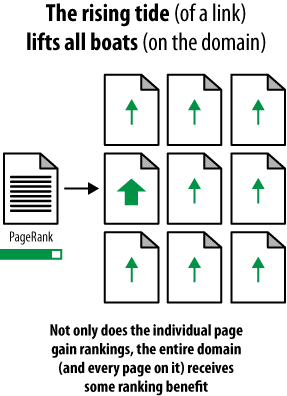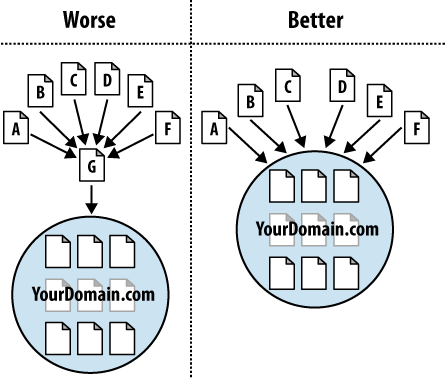4. Microsites
There is a lot of debate about microsites, and although we
generally recommend that you do not saddle yourself with the hassle of
dealing with multiple sites and their SEO risks and disadvantages, it is
important to understand the arguments, if only a few, in favor of doing
so.
4.1. Making the case for microsites
Optimized properly, a microsite may have dozens or even hundreds
of pages. If your site is likely to gain more traction and interest
with webmasters and bloggers by being at an arm’s length from your
main site, it may be worth considering—for example, if you have a very
commercial main site, and you want to create some great content,
perhaps as articles, podcasts, and RSS feeds, that do not fit on the
main site.
When should you consider a microsite?
When you own a specific keyword search query domain
For example, if you own “usedtoyotatrucks.com”,
you might do very well to pull in search traffic for the
specific term used toyota trucks with a
microsite.
When you plan to sell the domains
It is very hard to sell a folder or even a subdomain, so
this strategy is understandable if you’re planning to churn the
domains in the second-hand market.
As discussed earlier, if you’re a major brand building a
“secret” or buzz-worthy microsite
In this case, it can be useful to use a separate domain
(however, you really should 301 the pages of that domain back to
your main site after the campaign is over so that the link juice
continues to provide long-term benefit—just as the mindshare and
branding do in the offline world).
You should never implement a microsite that acts as a doorway
page to your main site, or that has substantially the same content as
you have published on your main site. Consider this only if you are
willing to invest in putting rich original content on the site, and if
you are willing to invest the time to promote the site as an
independent site.
Such a site may gain more links by being separated from the main
commercial site. A microsite may have the added benefit of bypassing
some of the legal and PR department hurdles and internal political
battles. This could be a key consideration if you’re at a monolithic
or low-risk-tolerance
organization.
However, a microsite on a brand-new domain may wallow in the
Google sandbox for months (for more about the Google sandbox). So, what to do if you want to
launch a microsite? Consider buying an aged, reputable domain
“aftermarket”—one that has had a quality site on it for a while
(parking pages don’t count!), and then change the domain registration
information slowly so that the site’s PageRank doesn’t get reset to
zero. Or start the clock running as soon as possible on your new
domain by posting at least a few pages to the URL and then getting a
few links to it—as far in advance of the official launch as
possible.
Here are the reasons for not using a microsite:
Search algorithms favor large, authoritative domains
Take a piece of great content about a topic and toss it
onto a small, mom and pop website—point some external links
to it, optimize the page and the site for the target terms, and
get it indexed. Now, take that exact same content and place it
on Wikipedia or CNN.com, or even SEOmoz—you’re
virtually guaranteed that the content on the large,
authoritative domain will outrank the content on the small niche
site. The engines’ current algorithms favor sites that have
built trust, authority, consistency, and history.
Multiple sites split the benefits of links
As suggested in Figure 2, a single
good link pointing to a page on a domain positively influences
the entire domain and every page on it. Because of this
phenomenon, it is much more valuable to have any link you can
possibly get pointing to the same domain to help boost the rank
and value of the pages on it. Having content or keyword-targeted
pages on other domains that don’t benefit from the links you
earn to your primary domain only creates more work.
100 links to Domain A ≠ 100 links to Domain B + 1 link to
Domain A (from Domain B)
In Figure 3, you can
see how earning lots of links to Page G on a separate domain is
far less valuable than earning those same links to a page on the
primary domain. Due to this phenomenon, even if you interlink
all of the microsites or multiple domains that you build, it
still won’t be close to the value you can get from those links
if they were to point directly to the primary domain.
A large, authoritative domain can host a huge variety of
content
Niche websites frequently limit the variety of their
discourse and content matter, whereas broader sites can target a
wider range of foci. This is valuable not just for targeting the
long tail of search and increasing potential branding and reach,
but also for viral content, where a broader focus is much less
limiting than that of a niche focus.
Time and energy are better spent on a single property
If you’re going to pour your heart and soul into web
development, design, usability, user experience, site
architecture, SEO, public relations, branding, and so on, you
want the biggest bang for your buck. Splitting your attention,
time, and resources on multiple domains dilutes that value and
doesn’t let the natural order of building on your past successes
on a single domain assist with that process. As shown in Figure 6-16, every page
on a site receives benefit from inbound links to a site. The
page receiving the link gets the most benefit, but other pages
also benefit.


5. When to Use a TLD Other Than .com
There are only a few rare situations in which you should consider
using a TLD other than .com:
When you own the .com and want to redirect to an .org, .tv,
.biz, and so on, possibly for marketing/branding/geographic reasons.
Do this only if you already own the .com and can redirect.
When you can use a .gov, .mil, or .edu domain (.jobs, though
technically restricted to HR and hiring organizations, is available
to anyone who hires and doesn’t have any special search
benefits).
When you are serving only a single geographic region and are
willing to permanently forego growth outside that region (e.g.,
.co.uk, .de, .it, etc.).
When you are a nonprofit and want to distance your
organization frmo the commercial world, .org may be for
you.